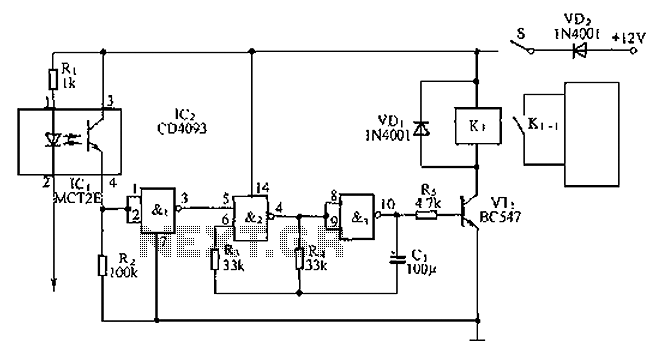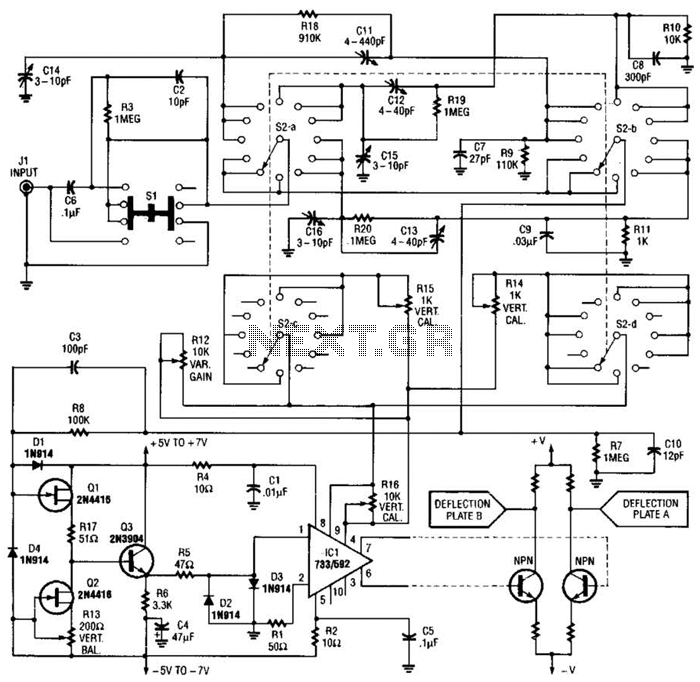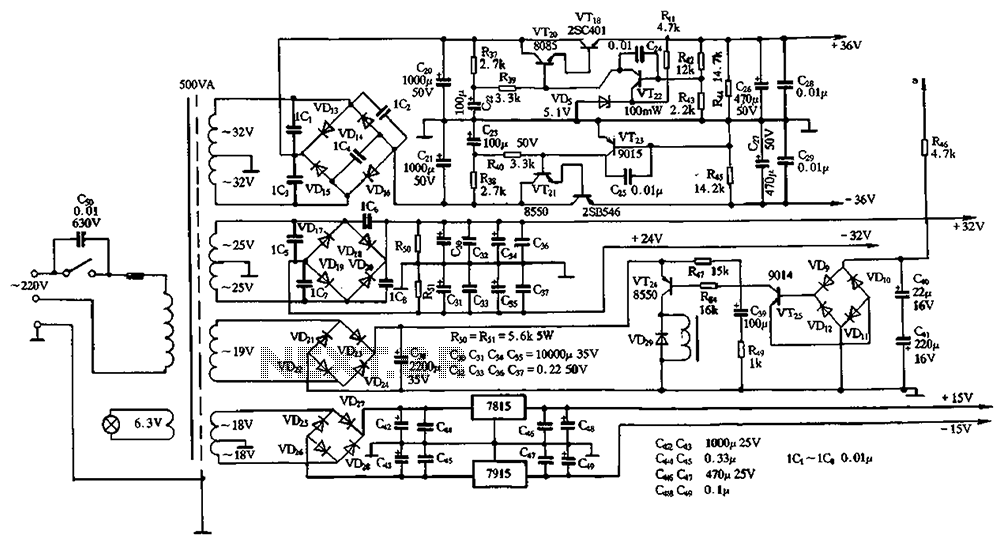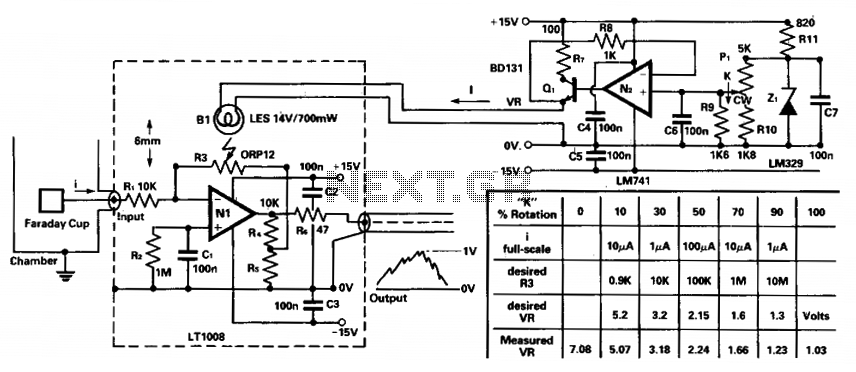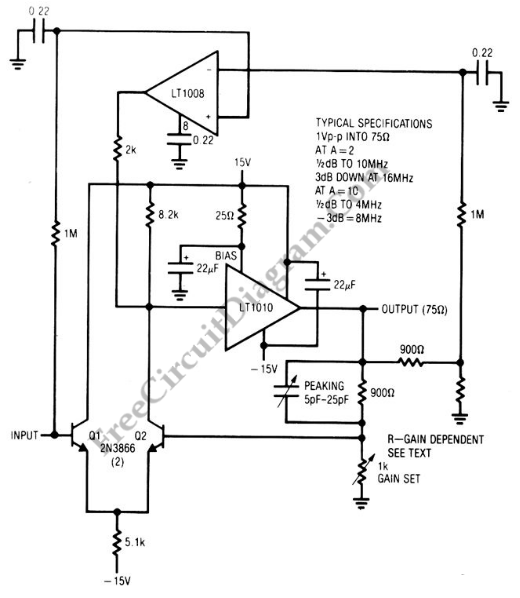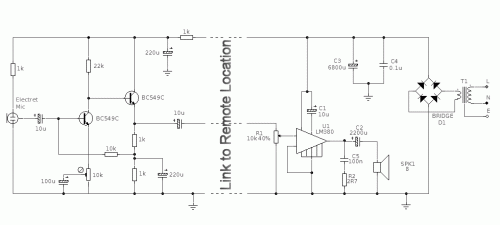
10W Audio Amplifier with Bass-boost
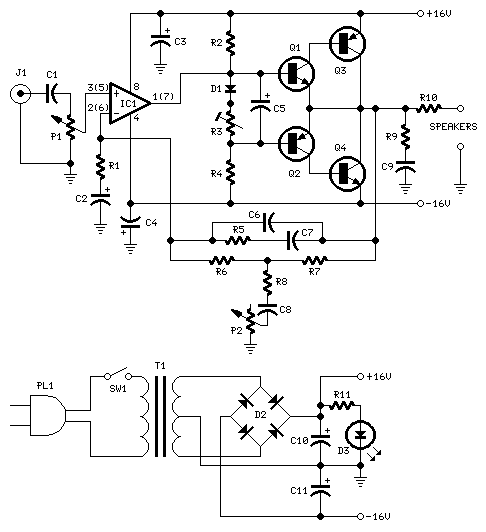
This design is based on an 18 Watt Audio Amplifier and was developed primarily to address the needs of users who have difficulty locating the TLE2141C chip. It utilizes the commonly available NE5532 Dual IC; however, its power output will be limited to the range of 9.5 to 11.5W, as the supply rails cannot exceed ±18V. Amplifiers of this type are often used to drive small loudspeaker cabinets, which can compromise the bass frequency range. To mitigate this issue without sacrificing sound quality, a bass-boost control has been incorporated into the feedback loop of the amplifier. The bass lift curve can achieve a maximum of +16.4dB at 50Hz. Even when the bass control is fully counterclockwise, the amplifier's frequency response exhibits a gentle rise: +0.8dB at 400Hz, +4.7dB at 100Hz, and +6dB at 50Hz (relative to 1kHz). Proper grounding is crucial to eliminate hum and ground loops; the ground connections for J1, P1, C2, C3, and C4 should be connected at the same point, and C9 should be connected to the output ground.
This audio amplifier circuit is designed to provide a reliable and effective solution for driving small loudspeaker systems while addressing common frequency response issues associated with such applications. The NE5532 Dual IC is selected for its favorable performance characteristics, including low noise and distortion, making it suitable for high-fidelity audio amplification.
The circuit configuration allows for a maximum output power of approximately 11.5W, which is adequate for small to medium-sized loudspeakers. The incorporation of a bass-boost control is particularly advantageous, as it allows users to enhance low-frequency performance without introducing significant quality degradation. The specified bass lift of +16.4dB at 50Hz ensures that the amplifier can deliver a satisfying low-end response, which is often a critical requirement in audio applications.
In terms of frequency response, the gentle rise in output at lower frequencies, even with the bass control set to its lowest position, indicates that the amplifier maintains a balanced sound profile. The specified frequency response adjustments (+0.8dB at 400Hz, +4.7dB at 100Hz, and +6dB at 50Hz) suggest that the design has been optimized to ensure clarity and presence across the audio spectrum, particularly in the bass region.
Grounding is a critical aspect of this design. To prevent hum and ground loops, all ground connections should be made at a single point. This practice minimizes potential interference and ensures a clean audio signal. Specifically, the ground connections for the input jack (J1), potentiometer (P1), and capacitors (C2, C3, and C4) should converge at a common point, while the output capacitor (C9) should also connect to this ground point.
Overall, this audio amplifier design balances power output, frequency response, and ease of implementation, making it an excellent choice for users seeking a reliable audio amplification solution without the need for hard-to-find components.This design is based on the 18 Watt Audio Amplifier, and was developed mainly to satisfy the requests of correspondents unable to locate the TLE2141C chip. It uses the widespread NE5532 Dual IC but, obviously, its power output will be comprised in the 9. 5 - 11. 5W range, as the supply rails cannot exceed ±18V. As amplifiers of this kind are freque ntly used to drive small loudspeaker cabinets, the bass frequency range is rather sacrificed. Therefore a bass-boost control was inserted in the feedback loop of the amplifier, in order to overcome this problem without quality losses. The bass lift curve can reach a maximum of +16. 4dB @ 50Hz. In any case, even when the bass control is rotated fully counterclockwise, the amplifier frequency response shows a gentle raising curve: +0.
8dB @ 400Hz, +4. 7dB @ 100Hz and +6dB @ 50Hz (referred to 1KHz). * A correct grounding is very important to eliminate hum and ground loops. Connect in the same point the ground sides of J1, P1, C2, C3 &C4. Connect C9 at the output ground. 🔗 External reference
This audio amplifier circuit is designed to provide a reliable and effective solution for driving small loudspeaker systems while addressing common frequency response issues associated with such applications. The NE5532 Dual IC is selected for its favorable performance characteristics, including low noise and distortion, making it suitable for high-fidelity audio amplification.
The circuit configuration allows for a maximum output power of approximately 11.5W, which is adequate for small to medium-sized loudspeakers. The incorporation of a bass-boost control is particularly advantageous, as it allows users to enhance low-frequency performance without introducing significant quality degradation. The specified bass lift of +16.4dB at 50Hz ensures that the amplifier can deliver a satisfying low-end response, which is often a critical requirement in audio applications.
In terms of frequency response, the gentle rise in output at lower frequencies, even with the bass control set to its lowest position, indicates that the amplifier maintains a balanced sound profile. The specified frequency response adjustments (+0.8dB at 400Hz, +4.7dB at 100Hz, and +6dB at 50Hz) suggest that the design has been optimized to ensure clarity and presence across the audio spectrum, particularly in the bass region.
Grounding is a critical aspect of this design. To prevent hum and ground loops, all ground connections should be made at a single point. This practice minimizes potential interference and ensures a clean audio signal. Specifically, the ground connections for the input jack (J1), potentiometer (P1), and capacitors (C2, C3, and C4) should converge at a common point, while the output capacitor (C9) should also connect to this ground point.
Overall, this audio amplifier design balances power output, frequency response, and ease of implementation, making it an excellent choice for users seeking a reliable audio amplification solution without the need for hard-to-find components.This design is based on the 18 Watt Audio Amplifier, and was developed mainly to satisfy the requests of correspondents unable to locate the TLE2141C chip. It uses the widespread NE5532 Dual IC but, obviously, its power output will be comprised in the 9. 5 - 11. 5W range, as the supply rails cannot exceed ±18V. As amplifiers of this kind are freque ntly used to drive small loudspeaker cabinets, the bass frequency range is rather sacrificed. Therefore a bass-boost control was inserted in the feedback loop of the amplifier, in order to overcome this problem without quality losses. The bass lift curve can reach a maximum of +16. 4dB @ 50Hz. In any case, even when the bass control is rotated fully counterclockwise, the amplifier frequency response shows a gentle raising curve: +0.
8dB @ 400Hz, +4. 7dB @ 100Hz and +6dB @ 50Hz (referred to 1KHz). * A correct grounding is very important to eliminate hum and ground loops. Connect in the same point the ground sides of J1, P1, C2, C3 &C4. Connect C9 at the output ground. 🔗 External reference
